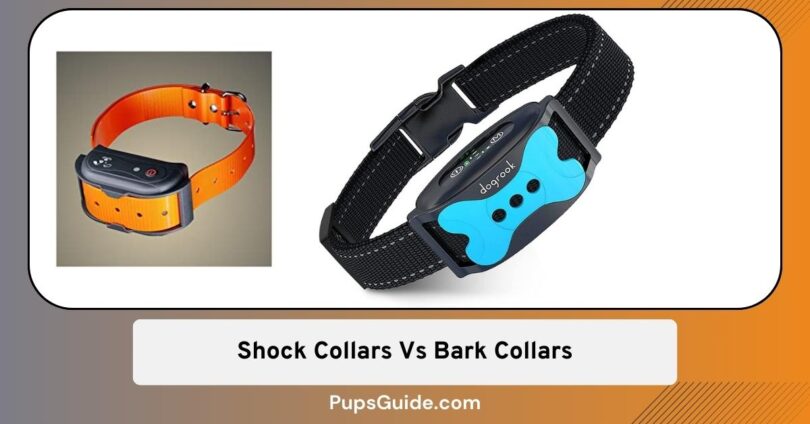Ever wondered about the difference between shock collars and bark collars when it comes to training your dog? Well, let’s dive into it and break it down, no fancy jargon or convoluted explanations.
What Is A Shock Collar? A Hands-On Approach
What’s the deal with shock collars, also known as electronic collars or e-collars? These gadgets are all about giving your dog a gentle electric nudge when they act out, mainly with the barking.
The benefit here is that it’s all in your hands, literally. You, the dog parent, are the one holding the reins, ready to zap when your pup starts yapping.
Now, let’s dissect the shock collar’s unique features:
1. Manual Control
With a shock collar, you’ve got to be on your toes. You’ll be the button pusher, zapping your dog with a little electric jolt whenever they kick up a fuss.
2. Instant Reaction
The beauty of this manual gig is that it’s all about quick fixes. The zap hits home the second you press that button. If you’re sharp and consistent, it can work wonders.
3. Potential for Frustration
But here’s the downside. Both you and your dog might end up a tad frustrated. Your pooch barks, you zap, they bark again, and it’s a never-ending loop.
4. Hit or Miss
The shock collar’s effectiveness hinges on your timing and consistency. If you don’t get it right, you might as well be barking up the wrong tree.
What Is A Bark Collar? Set It and Forget It
On the flip side, we’ve got bark collars. These devices are all about barking and nothing else. They’re like the hands-free option for dealing with your dog’s noisy outbursts.
Characteristics of a bark collar:
1. Automatic Mode
Bark collars are like your dog’s personal bouncer, equipped with sensors to detect their barking. When the yapping begins, the collar steps in without you lifting a finger.
2. Sensor Magic
Unlike shock collars, which need your input, bark collars are all about sensors, often picking up vibrations in your dog’s neck. It ensures the zap lands only when your furball gets chatty, not when the neighbors’ dogs join the chorus.
3. Gentler Approach
Some folks say bark collars are kinder. They deliver consistent and swift corrections without letting frustration or inconsistency sneak into the mix.
4. Options Galore
Bark collars come in all shapes and sizes. You’ve got citronella sprayers, vibrating models, and the electric zap kind. Experts often give the nod to the electric zap type for its effectiveness.
5. Smart Scaling
The cream of the crop in bark collars ramps up the correction gradually. It starts at a low level and only cranks up if your dog keeps barking. No unnecessary roughness here.
Pros and Cons
Let’s dissect the pros and cons of shock collars versus bark collars, so you can make an informed choice for your four-legged buddy.
Shock Collars Pros
1. Immediate Correction
The ace up the shock collar’s sleeve is its knack for quick fixes. With a remote control in your grasp, you can jump at the moment your dog kicks up a fuss, offering on-the-spot correction for undesirable behavior.
2. Customizable Intensity
Many shock collars give you the power to fine-tune the correction’s strength. This tailoring can be a game-changer, as every dog responds differently to jolts.
3. Versatile Training Tool
These gadgets aren’t just for barking blues. They can tackle digging, jumping, or aggression, making them a Swiss Army knife for dog trainers.
4. Effectiveness
When you get it right, shock collars can be a golden ticket for curbing unwanted antics. They dish out a consistent and dependable correction, which often leads to visible improvements in your pup’s behavior.
5. Remote Control
The remote control factor lets you reinforce commands and training in real-time. Super handy for off-leash training or when your furball is at a distance.
Shock Collar Cons:
1. Potential for Harm
Misuse of shock collars can spell trouble for your canine pal. Too much force or setting the intensity too high can bring pain and suffering, potentially leading to a nasty collar association.
2. Owner-Dependent
Shock collars lean on your constant presence and active involvement. If you drop the ball on vigilance and consistency, your training efforts might go up in smoke.
3. Risk of Overcorrection
In some cases, overdoing it can backfire. Trigger the collar too often or too harshly, and your dog might end up anxious or terrified, causing even more behavioral headaches.
4. Lack of Positive Reinforcement
Shock collars are all about punishment, but they don’t sprinkle any positive reinforcement magic. Balancing punishment with rewards is usually a more effective way to train your dog.
Bark Collars Pros
1. Automatic Operation
Bark collars are a hands-free option. They’re like your personal bouncer, responding to your dog’s barks without your direct input. This automatic response keeps the correction consistent.
2. Sensor-Based Stimulation
Bark collars tap into sensors to catch your dog’s barking, often using neck vibrations. They zap your pup only when they bark, not when the neighborhood’s hounds join the choir.
3. More Humane
Many folks see bark collars as the gentler option. Their consistent and immediate correction minimizes the chances of frustration and overcorrection.
4. Prevents Unnecessary Correction
Top-notch bark collars start with a gentle touch and only get tougher if your dog doesn’t pipe down. It’s a clever way to dodge undue harshness.
5. Diverse Options
Bark collars come in various flavors, from citronella spritzers to vibrating models and electric zappers. The electric zap type often gets the nod for its effectiveness.
Cons of Bark Collars:
1. Ineffectiveness for Other Training
While bark collars excel at taming barking, they might not cut it for other behavioral issues or teaching commands. If you’re on the hunt for a multi-purpose training tool, a bark collar may leave you wanting more.
2. Dependency on Technology
Bark collars have a soft spot for technology and sensors. But, like all things tech, they can have their off days. A malfunctioning collar might mean ineffective or, worse, unnecessary correction, and that’s no walk in the park.
3. Initial Cost
Quality bark collars can be a bit heavy on the wallet, with some models ringing up higher bills than basic shock collars. However, if you weigh the long-term benefits and the promise of a well-behaved pup, the initial investment might seem worthwhile.
4. Adjustment Period
Some dogs need a bit of time to warm up to the correction delivered by a bark collar. During this transition phase, your furball might get a tad perplexed or bothered, which could slow down the training.
5. Not One Size Fits All
Not all dog breeds are equally enchanted by electronic stimulation, which can put a dent in the effectiveness of bark collars. It’s vital to do your homework to figure out if a bark collar matches your dog’s breed and temperament.
Key Takeaways:
- Whether you lean towards shock collars or bark collars hinges on your training objectives, your dog’s quirks, and your ethical standpoint.
- Shock collars provide a rapid response and versatility but come with the baggage of potential harm and moral dilemmas.
- On the flip side, bark collars offer automatic, sensor-triggered correction, often viewed as more humane, though they may not be the jack-of-all-trades in the training department.
When to Choose a Bark Collar or a Training Collar? Using Collars for Specific Behaviors
When do you put those collars to good use, addressing common doggy behaviors? Here’s when.
1. Excessive Barking
If your pup can’t keep a lid on the barking, a bark collar is your go-to. Over time, it conditions them to associate barking with the collar’s nudge, leading to a quieter and less frazzled environment.
2. Recall Training
For off-leash recall training, e-collars can be your secret weapon. They gently remind your dog to heed your call, provided you start with low stimulation and link the recall command to positive outcomes, like treats or play.
3. Leash Reactivity
If your dog turns into a barky, leash-tugging whirlwind when they spot other dogs or people, e-collars can help rein them in. Use stimulation as a correction, but don’t forget to throw some positive reinforcement into the mix when your furball behaves nicely on a leash.
4. Boundary Training
Teaching your dog to respect boundaries, indoors and outdoors? E-collars can assist. Your pup needs to understand these limits, and the collar can step in when they test the waters.
5. Behavioral Modification
For trickier issues like aggression or separation anxiety, it’s best to enlist the help of a pro. They can guide you on using collars in a safe and effective manner, as part of a broader strategy to tackle these challenges.
A Word of Advice
Using special collars to address certain behaviors in your furry friend requires a careful and considerate approach. It’s all about keeping your dog’s well-being in mind at all times.
In fact, you need to prioritize your dog’s safety and emotional health throughout the entire training process. It’s important to remember that effective training goes beyond just slapping on a collar; it’s about creating a positive and enriching environment for your pup.
How To Train Your Dog With A Collar?
Now, if you’re thinking about using a bark or training collar for your dog, you’ve got to be on top of your game when it comes to proper training and introduction.
Let me walk you through a simple guide on how to get your dog accustomed to a bark collar:
1. Get Acquainted with the Collar
Start by putting the collar on your dog while it’s switched off. This way, your pup can get used to the idea of wearing it without any bells and whistles.
2. Begin at the Lowest Setting
When you’re ready to activate the collar, start at the lowest setting, which is usually a one or a two. The gentle stimulation acts as a starting point.
3. Watch Your Pup Closely
Keep a close eye on your dog’s behavior while the collar is on. Look for any signs of discomfort, such as how your dog reacts to the stimulation.
4. Adjust as Necessary
If your dog doesn’t respond to the low-level stimulation, gradually crank it up until you see some reaction. When your dog finally stops the incessant barking, that’s a sign that the collar is doing its job.
5. Transition to Automatic Mode
Once your dog is responding well to the manual setting, switch to the automatic mode. In this mode, the collar will adjust the stimulation level based on your dog’s barking behavior.
6. Keep an Eye on Your Pup
Always have your pup under your watchful eye when using a bark collar. Make sure it fits snugly but not too tight, and remember to remove it when it’s not needed.
Why Should You Use Collars Properly?
Regardless of the type you choose, the importance of using shock collars properly goes beyond. There are a few crucial considerations to keep in mind.
1. Safety First
Never leave a collar on your dog unattended, especially in situations where there are obstacles or other four-legged friends around. Collars can get snagged, and that poses safety risks.
2. Consistency Matters
Whether you opt for a shock collar or a bark collar, consistency in your training approach is key. Inconsistency can leave your dog scratching its head, figuratively speaking, and hinder any progress you’re making.
3. Training Is a Must
Collars should be just one part of a larger training program. Incorporate positive reinforcement and other training techniques to encourage good behavior.
4. Regular Monitoring
Keep a close eye on the collar’s fit to make sure it remains snug but not bothersome for your dog. Avoid prolonged use whenever possible.
Why Does My Dog Still Bark Even When I’m Using A Shock Collar?
Well, that’s a good one! Shock collars can be effective in curbing excessive barking for some dogs, but there are a few reasons your pup might keep on yapping, even with that collar on.
1. Insufficient Training
Properly introducing your dog to a shock collar and carrying out systematic training is absolutely crucial. If your dog hasn’t been properly conditioned to understand the consequences of barking, the collar might not do the trick. Some dogs may need a bit more time to adjust to the collar and learn from the stimulation.
Every dog is unique, and what works for one might not work for another. So, stay patient, be attentive, and work with your pup to find the best approach for their specific needs.
2. Getting the Fit and Settings Right
Making sure that the shock collar fits your dog correctly and is set at the right intensity is absolutely key.
If the collar’s too tight or too loose, it won’t deliver the correction effectively. Similarly, setting the collar to an inappropriate level can lead to your dog either ignoring the correction or getting excessively anxious.
3. Consistency, Consistency, Consistency
When it comes to training, being consistent is a deal-breaker. If you’re not using the shock collar consistently or applying it in response to each barking episode, your dog might not connect the correction with their behavior.
Inconsistent use can result in your pup scratching its head (figuratively) and less effective training.
3. Distracting Factors
Dogs are like sponges when it comes to their environment. If there are other dogs barking, loud noises, strange sights, and smells, or anything else grabbing their attention, it can overshadow the effect of the shock collar.
In these situations, your dog might keep on barking, no matter the stimulation.
4. Emotional States
Sometimes, if your dog is feeling fear, anxiety, or stress, the shock collar’s correction could make things worse. This might lead to even more barking or other behavioral issues.
5. Health and Discomfort
Don’t forget to consider any underlying health or pain issues that could be triggering your dog’s barking. If your pup is in pain or discomfort, they might bark to communicate that, and a shock collar won’t fix the root problem.
6. Breed and Personality
Shock collars can be a hit or miss depending on your dog’s breed and temperament. Some dogs and breeds are more sensitive to the stimulation, while others might be less responsive. What’s a miracle worker for one dog could be a dud for another.
7. Reinforcement of Barking
If your dog is getting attention or some form of reinforcement when they bark, that’s a tough nut to crack. For instance, if you engage with your dog when they bark, whether it’s a positive or negative interaction, it can actually reinforce the barking behavior.
8. Wrong Training Techniques
Here’s a golden rule: always use the shock collar in conjunction with positive reinforcement and proper training techniques. Relying solely on the collar’s correction without addressing the root cause of the barking won’t bring long-lasting results.
Shock Collars Vs Bark Collars – Conclusion
The choice between shock collars and bark collars is a decision that hinges on various factors, including your training goals, your dog’s individual quirks, and your ethical stance.
Shock collars provide quick responses and versatility but come with the baggage of potential harm and moral dilemmas. In contrast, bark collars offer automatic, sensor-triggered correction, often viewed as more humane, though they may not be versatile for all training needs.
Regardless of the type of collar you choose, always prioritize your dog’s well-being, safety, and emotional health throughout the training process. Remember that training goes beyond just the collar—it involves creating a positive and enriching environment for your dog.
Good Luck 🐶.








Leave a Comment